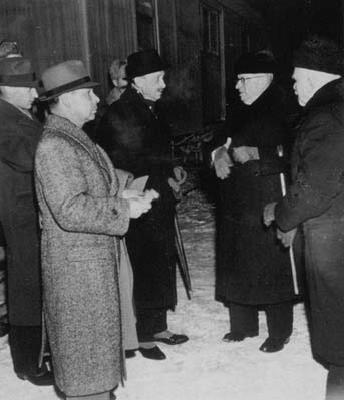


The line of policy which made allowances for the Russian security interests was called the Paasikivi Line. The first draft of the agreement from January 1945 is, however, to be credited to Mannerheim.
In 1945, there was little possibility for far-reaching political planning. The Soviet Union had concluded military pacts with the eastern Central European countries during the war, and it was to be expected that similar pacts would be offered to Finland as well. As early as 1938 and 1939, the Soviet Union had already proposed a defence alliance to Finland. The matter was brought up when arguments were presented to the Soviet Union of the utility of the coast artillery under the threat of dismantlement. Colonel General Zhdanov, the chairman of the Control Commission, sent Mannerheim some earlier Soviet agreements for perusal. Mannerheim used these agreements as the basis of his draft.
In that situation, necessity was made virtue by the Finnish military leaders. If this kind of agreement was inevitable, it should be as profitable as possible and contain as few negative points as possible. The conclusion of a union pact would have required the recognition of the sovereignity of Finland from the part of the Soviet Union, and might have sped up the process of making the final peace treaty. The new military political situation could also have meant deductions in war indemnity and territorial cessions. In his draft, Mannerheim confined the Soviet assistance, i.e. the arrival of Soviet troops on Finnish territory, to concern only those offensives that would be directed against Finland or the Soviet Union through Finnish territory. This suggested that Finnish troops should not be transferred somewhere else to fight the wars of the Soviet Union. The final Agreement of Friendship, Cooperation and Mutual Assistance had the same idea as its starting point.
Stalin was not, however, willing to continue the discussion in 1945. He did not want to recognize the independence of Finland or make peace with Finland until the general peace treaties were signed.
Mannerheim showed great concern for the fate of Finland even after his resignation from presidency in March 1946. He supported his successor, Paasikivi, but was rather pessimistic as to the Soviet intentions. The Porkkala military base might drag Finland into the war between the great powers. After Paasikivi had been elected president, he too began to oppose the idea of a defence alliance, and was accused of listening to Mannerheim’s advice.
After the ratification of the Paris Peace Treaty, the Soviet requirements for a union pact started to grow louder and more intense. Mannerheim took a clearly opposing view. As the peace treaty had set limitations on the military buildup of Finland and consequently put a check on her fighting capacity in advance, the country should not enter into a defence alliance that might lead her into war. Even Paasikivi objected to this kind of alliance till the end, the spring of 1948.
Trial of War Criminal | Agreement of Friendship, Cooperation and Mutual Assistance
COURSE OF LIFE | FAMILY | TIME OF GROWTH | MILITARY CAREER | WAR OF INDEPENDENCE | REGENT 1918-1919 | CIVILIAN | DEFENCE COUNCIL | COMMANDER-IN-CHIEF 1939-1946 | PRESIDENT OF THE REPUBLIC 1944-1946 | RETIREMENT | SPECIAL TOPICS | SEARCH